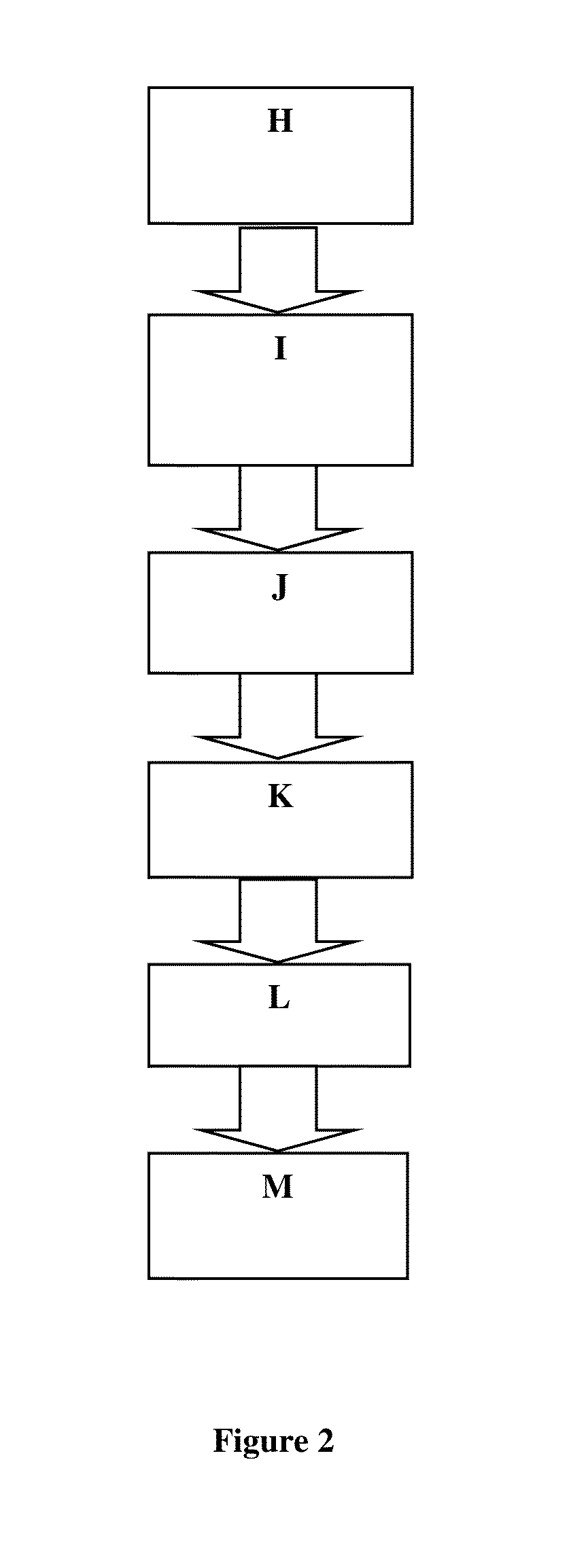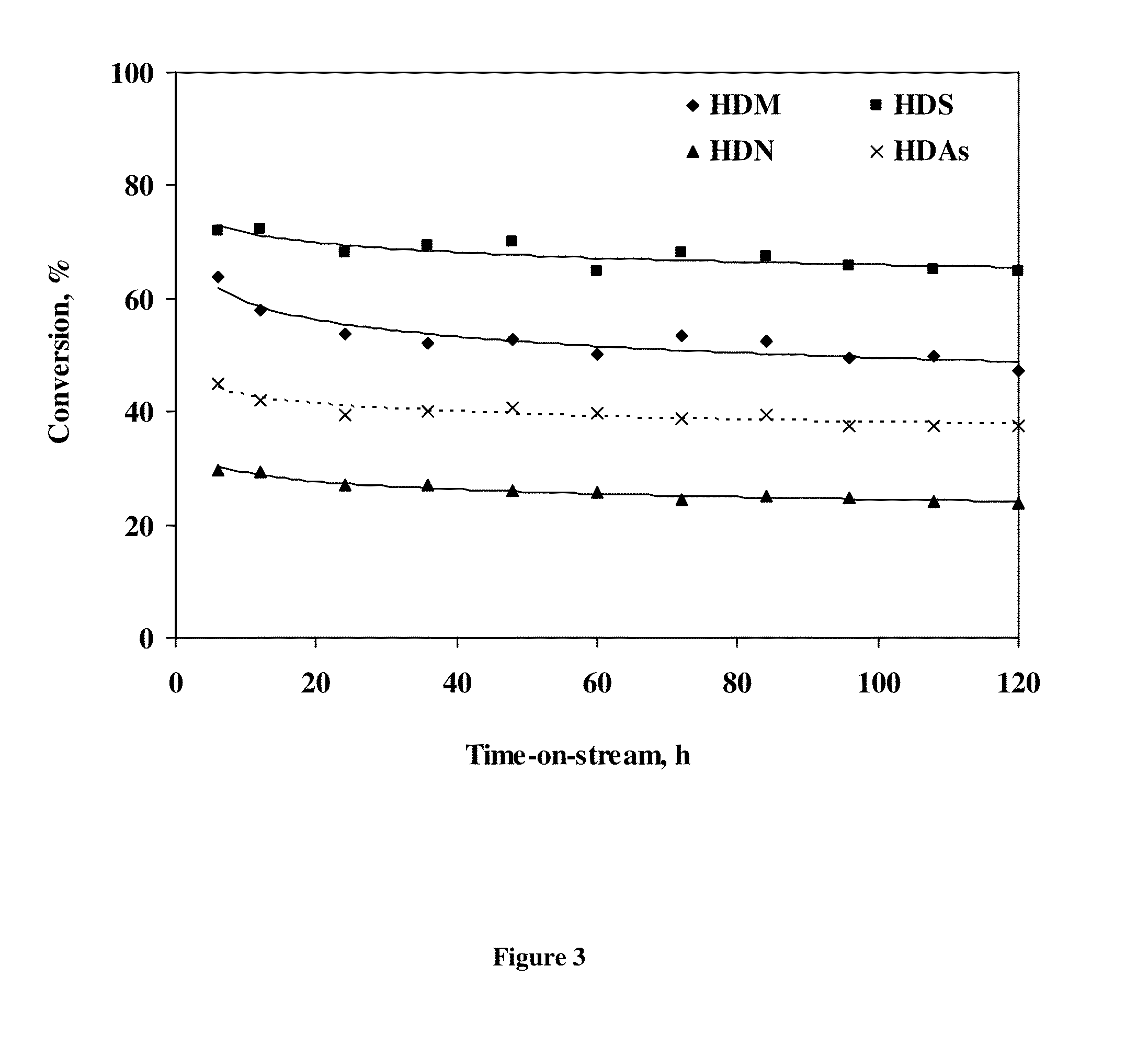Catalyst for the first hydrodemetalization step in a hydroprocessing system with multiple reactors for the improvement of heavy and extra heavy crudes
a technology of hydrodemetalization and catalyst, which is applied in the field of catalysts, can solve the problems of pore diffusion limitations, deactivation of catalysts at a very fast rate, and often affected performance of heavy oil hydroprocessing catalysts, and achieves high metal retention capacity, prolonging the operation life of hydroprocessing units, and high porosity
- Summary
- Abstract
- Description
- Claims
- Application Information
AI Technical Summary
Benefits of technology
Problems solved by technology
Method used
Image
Examples
example 1
[0038]A support hydroprocessing catalyst containing the reference aluminas from Table 1 was prepared by the following procedure. The dried 50 parts of catapal C1 alumina (Catapal C1 from Condea) and 50 parts pseudoboehmite alumina (Catapal 200 from Condea) were well mixed in equal proportion considering 25% moisture in both samples. To the mix, diluted HNO3 acid and sufficient amount of de-ionized water were added to form an extrudable paste (3-5 wt % HNO3 to the total powders). These weights are on 100% solids basis. The paste was extruded in 1 / 16″ cylinder, and dried at 100-120° C. overnight. The dried extrudates were calcined at 500-550° C. for 4 hours with purging of excess dry air to obtain a gamma alumina support, and cooled down to room temperature.
[0039]Impregnation of Co and Mo was done using a solution containing ammonium heptamolybdate and cobalt nitrate to the target metal loadings of 2.2 wt % CoO and 10 wt % MoO3 in the finished catalyst. The total volume of the solutio...
example 2
[0041]Catalyst 2, a CoMo catalyst containing alumina of the invention, was prepared using a procedure similar to Catalyst 1. For Catalyst 2, catapal 200 alumina of the invention from Example 1 was used to prepare the base extrudates. This catalyst is named Catalyst 2 (Cat-2) and its physical properties are summarized in Table 1. The texturales property of the catalyst (Cat-2) is shown in Table 1 where it is observed that catalyst contains mesoporous material.
[0042]Catalyst activities for HDS, HDM and HDAs were slightly higher than HDN. These activities were decreased with time-on-stream almost at similar magnitude as shown in FIG. 4.
example 3
[0043]Catalyst 3, a CoMo catalyst containing alumina of the invention, was prepared using a procedure similar to Catalyst 1. For Catalyst 3, 50 parts alumina (Pural SB, from Condea) of the invention from example 1 and 50 parts pural TH alumina (Pural TH 100, from Sasol) were used to prepare the base extrudates. This catalyst is designated Catalyst 3 (Cat-3) and its physical properties are summarized in Table 1. The textural properties of the catalyst (Cat-2) are shown in Table 1 where it is observed that the catalyst contains mesoporous material.
[0044]The catalyst showed almost similar activity for HDS, HDM and HDAs. These activities decreased with time-on-stream almost at similar magnitude as shown in FIG. 5.
PUM
| Property | Measurement | Unit |
|---|---|---|
| radius | aaaaa | aaaaa |
| radius | aaaaa | aaaaa |
| temperature | aaaaa | aaaaa |
Abstract
Description
Claims
Application Information
 Login to View More
Login to View More - R&D
- Intellectual Property
- Life Sciences
- Materials
- Tech Scout
- Unparalleled Data Quality
- Higher Quality Content
- 60% Fewer Hallucinations
Browse by: Latest US Patents, China's latest patents, Technical Efficacy Thesaurus, Application Domain, Technology Topic, Popular Technical Reports.
© 2025 PatSnap. All rights reserved.Legal|Privacy policy|Modern Slavery Act Transparency Statement|Sitemap|About US| Contact US: help@patsnap.com



